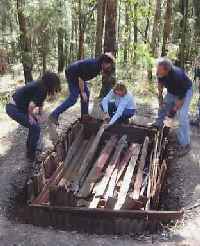
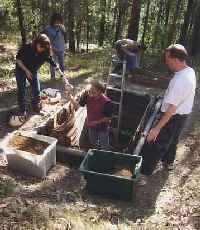 This
is me handing the pots down to John in the the pit, who is stacking them, and
packing them in sawdust.
This
is me handing the pots down to John in the the pit, who is stacking them, and
packing them in sawdust.Pit firing at Kulnura.
In June 2005, the Certificate III class from Hornsby TAFE, ie "the Beginners", participated in a primitive style pit firing on a property at Kulnura on the Central coast. All the pots have already been bisque fired to 1000°C, so it is not really a true primitive firing, however we aim to minimise the number of breakages that would occur firing raw pots in this way, and also produce a much stronger pot since pit style firings typically do not exceed 900°C.
The surface of the pots has been prepared in various ways in order to enhance the decorative effects of the firing, such as spraying with a copper carbonate and salt solution and covering with seaweed and copper wire. For some pots, we used old tins as saggars tightly packed with sawdust, in order to achieve deep blacks by carbonising the clay throughout.

 This
is me handing the pots down to John in the the pit, who is stacking them, and
packing them in sawdust.
This
is me handing the pots down to John in the the pit, who is stacking them, and
packing them in sawdust.
After the pots have been completely covered with sawdust, they are covered first with a layer of crumpled newspaper which is them completely covered with a layer of timber. In this case we are using old fence palings.
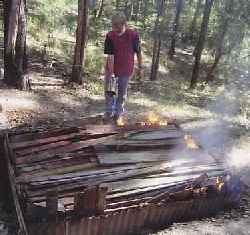 Petrol
is used to set the pit alight .
Petrol
is used to set the pit alight .
On the right, the fire in
full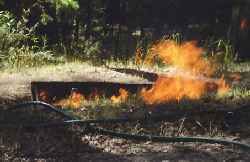 swing. Note the hosepipe in the foreground just in case of any emergencies!
swing. Note the hosepipe in the foreground just in case of any emergencies!
Soon after this, when the fire was really well established, the pit was covered with a sheet of corrigated iron, which had the dual function of forcing the fire down into the sawdust and protecting it from the weather if it should rain, (We wish! New South Wales is currently suffering the worst drought on record.)
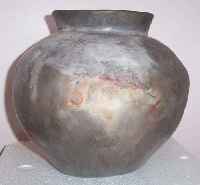 The
pit was left to burn for a week and when we reconvened to unpack it, there were
still burning embers and many of the pots were still too hot to handle.
The
pit was left to burn for a week and when we reconvened to unpack it, there were
still burning embers and many of the pots were still too hot to handle.
The effects were very successfull, ranging from the pure black of the saggar fired pieces, to a range of pinky greys from the copper carbonate.